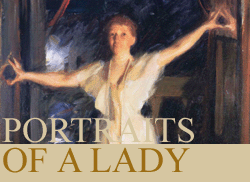
The Isabella Stewart Gardner Museum celebrates its centennial with the new exhibit The Making of the Museum: Isabella Stewart Gardner as Collector, Architect and Designer
by Scott Roberto

|
Isabella Stewart Gardner and her museum, basking in the limelight for more than a century, have spawned their fair share of salient tidbits:
|
Before iconoclastic Boston socialite and art collector Isabella Stewart Gardner passed away in 1924, she decreed that her beloved collection of art treasures was to forever remain as she had left them. That means that nothing was to be added, not even the usual museum labels standard at other institutions. Gardner-or "Mrs. Jack," an affectionate nickname gleaned from her husband, John Lowell "Jack" Gardner-wanted to provide a place "for the education and enrichment of the public forever." She did so by creating the Isabella Stewart Gardner Museum, which remains the only art museum in which everything, from the building itself to the arrangement of the numerous paintings, sculptures, tapestries and architectural elements, are the vision of one individual.
In honor of the 1903 opening of the museum, a year-long celebration is taking place. A cornerstone of the festivities is the new exhibit The Making of the Museum: Isabella Stewart Gardner as Collector, Architect and Designer, on display until the end of the summer. It serves not only as an account of the museum's creation, but also as a tribute to its creator.
Believing that "the greatest need in our country was art," as she wrote in 1917, Mrs. Gardner, the recipient of a sizeable inheritance, undertook the task of acquiring one of the finest private collections of her era. Masterpieces by such giants as Botticelli, Rembrandt, Vermeer and Titian, as well as works by contemporaries and friends John Singer Sargent and James McNeill Whistler, were purchased in a relatively short period of time, many with the help of trusted advisor Bernard Berenson. When her Back Bay home could no longer contain her voluminous holdings, she decided to build a museum in order to share her collection with the public. After purchasing several plots of land in the then-underutilized Fenway area of Boston, she began the early stages of construction of the Venetian palazzo-inspired "Fenway Court," as the museum was originally called, in 1899.
The exhibit itself consists largely of a multitude of documents that chronicle the building of the museum from 1899 to 1902, including blueprints, architectural drawings, journal entries and newspaper clippings, some of which have never before been displayed to the public. These artifacts show the integral role that the oft-demanding Mrs. Gardner played in every aspect of the edifice's creation. Also included are the sometimes humorous transcripts from the diaries of architect Willard T. Sears, whose workmen often butted heads with Mrs. Gardner-and vice versa. Not to be overlooked are accounts from Mrs. Gardner's personal diaries, and even a few of her watercolors, from travels to Italy, Egypt, Japan and everywhere in between.
After a year of painstakingly installing her collection throughout the galleries, which center around the breathtaking, skylit garden courtyard (pictured left), the building was finally ready in early 1903. The museum quickly became a hub for intellectual and artistic life in Boston. Friends and those admired and supported by Mrs. Gardner over the years, such as writer Henry James, dancer Ruth St. Denis, composer Charles Martin Loeffler and philosopher George Santayana, at one time or another made appearances at Fenway Court.
Mrs. Gardner's legacy as a
supporter of the visual, literary and performing arts is
continued today by the artist-in-residence program as well as
regular scholarly lectures and musical performances. Current
artist-in-residence Joseph Kosuth has created several text-based
pieces based on the correspondence of Gardner and her friends
that are on view inside, as well as on the outer wall of the
museum as a brilliant neon sign. Thanks to Mrs. Gardner's
consideration of every detail-not to mention her unbridled
generosity-visitors, be they artists or art admirers, can
continue to be inspired by her vision 100 years later.
back to homepage
